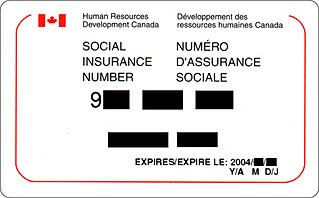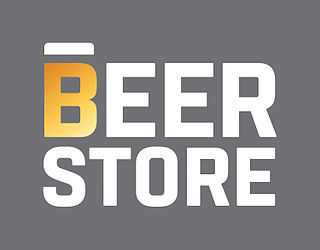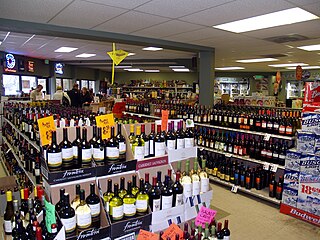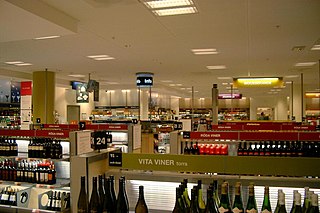An identity document is any document that may be used to prove a person's identity. If issued in a small, standard credit card size form, it is usually called an identity card, or passport card. Some countries issue formal identity documents, as national identification cards that may be compulsory or non-compulsory, while others may require identity verification using regional identification or informal documents. When the identity document incorporates a person's photograph, it may be called photo ID.

A social insurance number (SIN) (French: numéro d'assurance sociale (NAS)) is a number issued in Canada to administer various government programs. The SIN was created in 1964 to serve as a client account number in the administration of the Canada Pension Plan and Canada's varied employment insurance programs. In 1967, Revenue Canada (now the Canada Revenue Agency) started using the SIN for tax reporting purposes. SINs are issued by Employment and Social Development Canada (previously Human Resources Development Canada).

The Liquor Control Board of Ontario (LCBO) is a Crown corporation that retails and distributes alcoholic beverages throughout the Canadian province of Ontario. It is accountable to the Legislative Assembly through the minister of finance. It was established in 1927 by the government of Premier George Howard Ferguson to sell liquor, wine, and beer. Such sales were banned outright in 1916 as part of prohibition in Canada. The creation of the LCBO marked an easing of the province's temperance regime. By September 2017, the LCBO was operating 651 liquor stores.

Brewers Retail Inc., doing business as The Beer Store, is a privately owned chain of retail outlets selling beer and other malt beverages in the province of Ontario, Canada.

A liquor store is a retail business that predominantly sells prepackaged liquors, wine or beer, usually intended to be consumed off the store's premises. Depending on region and local idiom, they may also be called an off-licence, off-sale, bottle shop, bottle store or, colloquially, bottle-o, liquor store or other similar terms. A very limited number of jurisdictions have an alcohol monopoly. In US states that are alcoholic beverage control (ABC) states, the term ABC store may be used.
Alcohol server training is a form of occupational education typically provided to servers, sellers and consumers of alcohol to prevent intoxication, drunk driving and underage drinking. This training is sometimes regulated and mandated by state and local laws, predominantly in North America, and increasingly in other English-speaking countries such as Australia. In some places, such as Australia, gaining such qualifications is required by law, before one can work to sell alcohol.

Canadian wine is wine produced in Canada. Ontario and British Columbia are the two largest wine-producing provinces in Canada, with two-thirds of the Canada's vineyard acreage situated in Ontario. However, wine producing regions are also present in other provinces, including Alberta, Quebec, New Brunswick and Nova Scotia.
This article covers various topics involving alcoholic drinks in Canada. The Government of Canada defines an alcoholic drink as "a beverage containing 1.1% or more alcohol by volume."
The Liquor Licence Act of Ontario is a provincial act in Ontario dealing with licensing and possession of alcohol. In most cases, the Act impacts eateries requiring a licence to serve alcohol.

A liquor license is a governmentally issued permit to sell, manufacture, store, or otherwise use alcoholic beverages.

An alcohol monopoly is a government monopoly on manufacturing and/or retailing of some or all alcoholic beverages, such as beer, wine and spirits. It can be used as an alternative for total prohibition of alcohol. They exist in all Nordic countries except Denmark proper, and in all provinces and territories in Canada except Alberta. In the United States, there are some alcoholic beverage control states, where alcohol wholesale is controlled by a state government operation and retail sales are offered by either state or private retailers.
Crown corporations in Canada are government organizations with a mixture of commercial and public-policy objectives. They are directly and wholly owned by the Crown.
Alcohol laws of Australia are laws that regulate the sale and consumption of alcoholic beverages. The legal drinking age is 18 throughout Australia. The minimum age for the purchase of alcoholic products in Australia is 18. A licence is required to produce or sell alcohol.

The serving of alcohol in the Commonwealth of Massachusetts is governed by the Alcoholic Beverages Control Commission (ABCC), which is responsible for issuing licenses and permits for all manufacturers, wholesalers and importers, out-of-state suppliers, brokers, salespeople, warehouses, planes, trains, ships, ship chandlers and vehicles transporting alcoholic beverages.
In Canada, provincial driver's licences are the primary form of government-issued photo ID. Most Canadian provinces produce photo ID cards for Canadians who do not drive. A common feature of these cards is that it cannot be held concurrently with a valid drivers licence.

BC Liquor Stores are a chain of government-owned and operated retail outlets operated by the British Columbia Liquor Distribution Branch to distribute alcoholic beverages in the province of British Columbia, Canada. They are accountable to the Attorney General of British Columbia. BC Liquor Stores currently operate 198 locations across the province. The chain was established in June 1921, following the result of a plebiscite in favour of liquor availability through government liquor stores. Prior to the plebiscite, alcohol had been illegal through the Prohibition Act, introduced on May 23, 1916, with exceptions for sacramental, medicinal or industrial purposes.
Australia does not have a national identity card. Instead, various Identity documents of Australia may be used or required to prove a person's identity, whether for government or commercial purposes such as:
A plebiscite on Nova Scotia's prohibition of alcohol sales was held on October 31, 1929. Voters authorized the repeal of the Nova Scotia Temperance Act. This result opened the door to sales of alcohol in a government monopoly of liquor outlets and created the Nova Scotia Liquor Commission on May 1, 1930.

On October 17, 2018, cannabis was legalized in Canada for recreational and medical purposes. It was already legal for medicinal purposes, under conditions outlined in the Marihuana for Medical Purposes Regulations issued by Health Canada, and for seed, grain, and fibre production under licence by Health Canada.
In the Canadian province of Ontario, severe restrictions on the sale and consumption of alcoholic drink were imposed in localities during the later 19th century. Prohibition was imposed across the province under the 1916 Ontario Temperance Act, until restrictions were somewhat eased with the passage of the Liquor Control Act of 1927 which set up the still existing Liquor Control Board of Ontario. Regulations were further amended in 1934.










